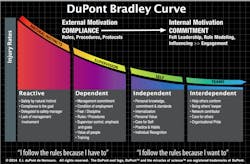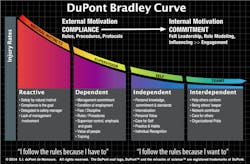The Path to Operational Excellence Through Operational Discipline
Striving to achieve operational excellence is one of the most important contributors to an organization’s sustainable performance and growth.
Companies that reach for a higher level of operational excellence reap numerous benefits -- a systemic, evolving and effective approach to business operations; a continually productive and innovative workforce; and an organization that consistently realizes sustainable growth and increasing valuation.
But what exactly is “operational excellence”? It isn’t necessarily a destination; rather, it is an ongoing journey that organizations continuously travel. It focuses on minimizing and managing downside risks while maximizing an operation’s performance and shareholder value.
Along the way, numerous factors are essential to the success of the journey. One of them is operational discipline.
Discipline: A Critical But Challenging Step toward Operational Excellence
It isn’t unusual to confuse operational excellence with operational discipline. While the two are closely linked -- indeed, the former cannot be realized without the latter -- operational discipline is but one important component among others along the journey to operational excellence.
DuPont Sustainable Solutions (DSS) defines operational discipline as “the deeply rooted dedication and commitment by every member of the organization to carry out each task the right way every time.”
Simply put, operational discipline means complying with a set of well-thought-out and well-defined processes, and consistently executing them correctly. It’s an essential ingredient when trying to achieve operational excellence.
Operational discipline provides an organized way to accomplish tasks and implement operational changes through a fundamental set of procedures that are specific to a business’s unique products or service offerings.
Regardless of the industry, operational discipline increases reliability and decreases the risk of a high-consequence incident occurring. DuPont Sustainable Solutions’ Safety Perception Survey of our clients across the globe, representing sectors from oil and gas to chemicals, confirms that disciplined processes yield positive results. Survey participants who had strong incident investigation processes in place and implemented investigation recommendations saw a correlation with strong safety performance.
But it is not just about safety. Operational discipline improves the execution and performance of the work practices across an organization to a point where leaders and employees consistently and continuously address the day-to-day operational needs of the business in a timely, safe and efficient manner.
Discipline = Predictability
For some, operational discipline can have a negative connotation. For example, it is sometimes interpreted as a means to punish behavior and actions that are not in line with expected norms. Still others may believe that operational discipline imposes rigid, inflexible command-and-control regimens that stifle free thought and innovation within a company.
Neither of these is the case. In fact, the word discipline comes from the Latin word disciplina, which refers to teaching and learning.
When companies employ operational discipline as a means of providing more predictability across their organizations, certain tasks reach higher levels of efficiency, contributing to fewer mistakes and better quality.
As a result, time and opportunities open up for everyone to focus on elevating performance and results. There is a ripple effect of benefits, each having the power to unleash rapid and continuous improvement, as well as waves of innovation.
Effective operational discipline can be seen day in and day out within high-risk industries like nuclear power or aviation, where the consequences of an accident can be so catastrophic that the importance of reliability raises itself to a very high level. These high-reliability organizations nearly always achieve “error-free operations” due to their strong operational discipline.
A small mistake may not necessarily lead to catastrophic consequences for every organization, but every business, along with its stakeholders surely benefit from raising performance to higher levels of excellence.
The Importance of Leadership
But how do businesses bridge the gap from simply being an “error-free” organization to becoming a consistently high-performing organization that approaches operational excellence? The answer, in a word, is leadership.
“Doing it right every time” is great, but operational discipline alone isn’t enough for organizations to approach operational excellence. High-performing organizations leverage their error-free operations to focus on and address other critical operational improvements within the organization that allow it to reach a higher level of operational excellence. One factor that’s key to reaching these higher levels of operational excellence is the deep involvement of an organization’s leadership.
Leadership is essential to establishing the appropriate organizational structure and focused processes that will improve operational excellence. Leadership articulates and defines the shared values and common purpose, and prioritizes the things that truly matter to drive the highest levels of operational excellence. The direction needed to support this is delivered to the organization through proper tools and training, as well as employee involvement, clear communication of the rules, open dialogue and alignment.
When management leaves it entirely up to workers to determine how to do a process the right way, everyone ends up doing it in a manner they individually think is best, leading to inconsistency and inefficiency.
Avoid Overly Complicated OpEx Systems
Also, not all requirements are a priority for every worker at every process within an organization. In fact, when requirements are conveyed to all workers with the same level of importance, it overburdens and overwhelms an organization to the extent that very little or nothing gets the attention that’s needed.
When organizations create far-reaching, complicated operational excellence management systems, they are often unable to execute their plans. Success comes when leaders at every level of the organization focus on identifying the “critical few” items that are essential.
Leaders also help drive a standardized process for pursuing operational excellence.
Standardization reduces variations that can lead to inefficiencies and even hazards. A standardized approach helps ensure that every worker who is charged with the responsibility of improving a process approaches it in the same way, using the same techniques.
Along with standardized processes, it is equally essential that leaders foster a sense of collaboration among all levels of an organization. Collaboration and engagement result in higher levels of transparency and trust within an organization.
When employees feel they can rely on one another, a natural work rhythm evolves because there’s less hesitation or second guessing. When employees feel they are in a just and fair environment where their concerns and questions are welcome, new ideas and continuous improvement flourishes.
Further, empowered employees assume responsibilities they might not otherwise take on. Teamwork and empowerment contribute to creating, maintaining and sustaining operational excellence, which increases reliability and minimizes errors in the organization.
Finally, cultivating a culture of excellence requires leaders to “walk the walk, not just talk the talk.”
Highly effective leaders demonstrate what they want to achieve in their organization and provide the energy to make it a reality. The tone is set at the top and carries across the organization.
At every level, this “felt leadership” demonstrates a commitment to operational discipline that enables everyone to understand and accept the importance of it in their daily tasks, which is a key step in the journey toward operational excellence.
A Culture of Interdependency: A Driver and Indicator of Operational Excellence
An organization’s journey to operational excellence can be a complicated one. DuPont Sustainable Solutions has an effective model, known as the DuPont Bradley Curve, to help companies measure their progress toward development of an effective operating culture that is essential to the pursuit of operational excellence.
The DuPont Bradley Curve is a much cited, leading quantitative indicator of organizational culture and maturity. It is used extensively with our client organizations in various industries and countries. It is a method for measuring how a company’s goals for organizational excellence become incorporated within company culture, and how that culture can be enhanced.
As mapped out by the DuPont Bradley Curve, people in an organization move from externally applied discipline (from supervisors, for instance) to self-discipline, to a state of interdependency in which they help each other perform better.
To reach an interdependent mindset, an organization examines its work routines and determines what is preventing it from reaching its goals. This progression is reflected in the DuPont Bradley Curve, where there is a significant hurdle between the second and third stages, moving from dependency to independency.
Operational discipline accelerates progress along the Bradley Curve. In fact, according to DuPont Sustainable Solutions’ Safety Perception Survey, operational discipline, in which an organization’s leaders enable employees to feel empowered to assume responsibility for safety (as mentioned in “The Importance of Leadership,” above), was shown to be a key contributor toward reaching interdependency.
The Bradley Curve is an effective modeling tool that helps organizations assess where they stand and chart an effective path forward. It helps them identify obstacles and answer key questions toward implementing effective operational discipline, as a requirement to the achievement of operational excellence.
Conclusion
One way for companies to think about operational excellence is to compare the organization to an athlete in training for a marathon. An athlete would never attempt to run a marathon without first committing to a rigorous training regimen that will enable them to finish the race. Dynamic companies approach operational excellence in much the same way.
For a host of reasons, from cost pressures and the implementation of new business models or technologies, to the challenges brought about by mergers, shifts in workforce, and knowledge transfer needs; organizations are recognizing the importance of operational discipline in preparing themselves to make the run for operational excellence. Getting an entire organization to excel at it isn’t easy, but as leaders show a commitment to achieving operational discipline, employees take up the challenge and deliver increasing levels of interdependence, innovation and sustainable growth.
Brian Rains leads the DuPont Sustainable Solutions Operational Excellence Practice, helping companies achieve synergistic, sustainable, and measurable benefits such as increased productivity, improved quality, increased asset uptime and improvement in human safety and environmental footprint.

